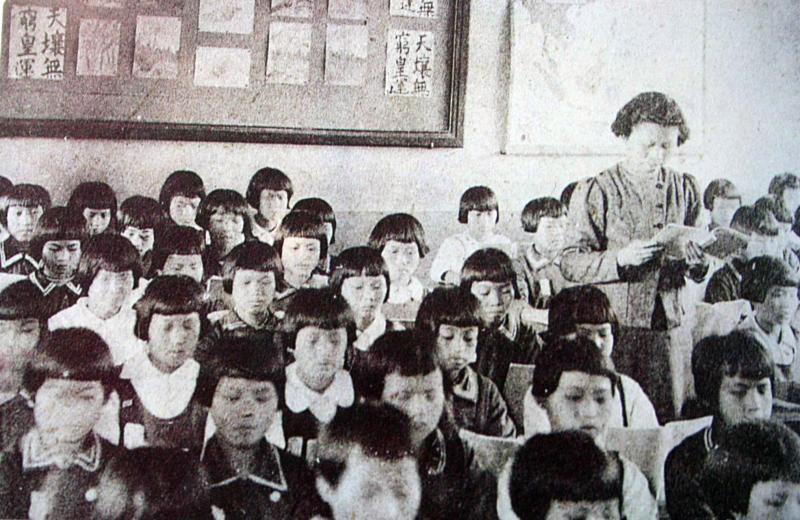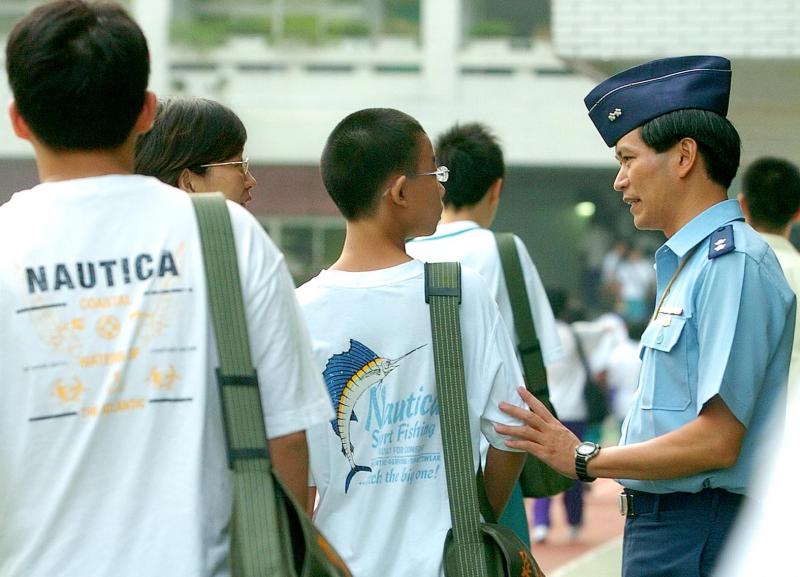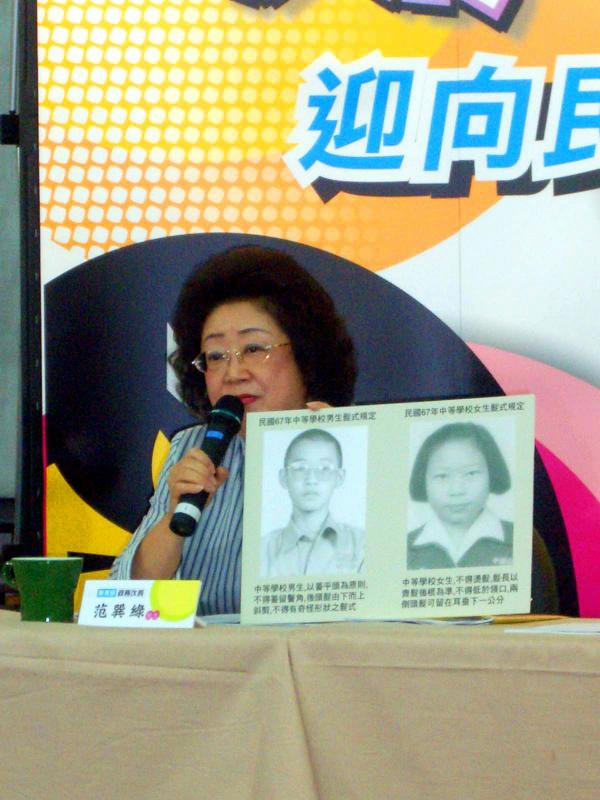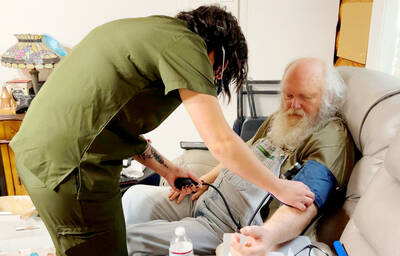Jan. 18 to Jan. 24
Viewers couldn’t believe their eyes when the Taipei First Girls’ Senior High School marching band appeared on television in 1981.
None of the girls were sporting the government-mandated hairstyle for female secondary school students, which forbade their hair from going past their neck. Some even had perms.

Photo courtesy of Yang Lien-fu
The students had been invited to perform in the US, which the government saw as an important affair since the US had severed official ties two years earlier. The idea was that sending a group of girls with the same permitted hairstyle would appear contradictory to the “free and democratic” values of the US as well as the image Taiwan was trying to promote, to distinguish it from Communist China.
It caused quite a stir, and newspapers ran editorials wondering if other students would begin to wear their hair long, and even if such restrictions were necessary. Responding to the voices of the students, Guting Girls’ Junior High School (古亭女中) was the first to repeal the restrictions, but the Ministry of Education forced them to reinstate it.
It wasn’t until Jan. 20, 1987, that the government officially removed its restrictions on hairstyles for all secondary school students. However, almost all schools continued to impose their own rules on students’ hair, and punished them for violations.

Photo: Wang Min-wei, Taipei TImes
THE QUEUE QUESTION
Government control over citizen hairstyles had long been a form of social control. The Manchu-style queue, for example, was a symbol of submission to the Qing Empire. Cheng Ke-shuang (鄭克塽), the grandson of Ming Dynasty loyalist Koxinga, was forced to adopt the hairstyle in 1683 when the Qing vanquished his Tainan-based Kingdom of Tungning (東寧), and when peasant Chu Yi-kuei (朱一貴), led a revolt against the Qing in 1721, his men cut off their queues.
When the Qing ceded Taiwan to Japan in 1895, the new colonial masters announced the wearing of a queue as one of “three major Taiwanese backward practices,” along with foot-binding and opium smoking, that needed to be stamped out.

Photo: Shen Hui-yuan, Taipei Times
When prominent tea merchant Lee Chun-sheng (李春生) visited Japan in 1896, locals mocked him as a “pig-tailed slave,” prompting him to become one of the first notable Taiwanese to cut off his queue, lamenting that he had been abandoned by his motherland anyway.
Similarly, other Taiwanese were reluctant to cut off their queue because this symbolized their status as a conquered people.
Writer Chang Shen-chie (張深切) lamented: “Our entire family wept in front of the family altar when we cut our queue. We were deeply ashamed ... that we cut our hair, accepted Japanese education and have become Japanese citizens. I pray that once we chase the Japanese devils out, we can grow our hair back to repay our ancestral spirits.”
By 1915, only about 80,000 men in Taiwan retained queues — mostly old people who were allowed to keep them. For women, the focus was on foot-binding.
As for schools, students began wearing Western-style uniforms starting around 1920, and a great deal of importance was put on students’ appearance, which presumably included hair. There doesn’t seem to be any specific or unified guidelines, but most boys shaved their heads and girls either wore it short or in braids.
NO HIPPIES ALLOWED
Hair restrictions returned during the Martial Law era — men were forbidden to wear their hair too long, for example. There didn’t seem to be hair rules for women in general (presumably it couldn’t be too outrageous); the authorities were more concerned about them showing too much skin. A 1971 Taiwan TV (台視) clip shows over 100 men who were taken to the police station to be forcefully given haircuts. Curiously, the hair of the men shown in the video can barely be considered “long” by today’s standards.
People, of course, didn’t always follow the law. Taiwan Provincial Assemblyman Tu Yen-ching (涂延卿) in 1978 urged the government to firmly clamp down on “unusual clothes and long hair,” adding that Taiwan should even refuse entry to foreigners who looked like “hippies.”
“The [excessive freedom] in Western countries has perverted the minds of their citizens, causing them to become dispirited, hopeless and confused — which has given to the rise of ‘hippies!’” Tu said. “Their bodies are unkempt, their behavior is odd, they have long hair and wear strange clothes; it’s as if they’ve lost their minds. This has spread to Asia in recent years, and has caused the hearts of our youth to waver as they believe that such behavior is fashionable.”
But most notable were the hair restrictions in schools: In 1950, the Ministry of Education sent the following order to all secondary schools: “Inspections of secondary students have found that many have long hair or varied styles. This is unsightly and a waste of time for the students. In order to promote the values of cherishing time, cleanliness and austerity, we mandate that beginning from this semester, all secondary schools should require that their boys shave their heads and all girls cut their hair short.”
These rules were written into law in 1969, and were again reiterated in 1978.
FREEDOM FOR HAIR
Although government-mandated hair restrictions on secondary school students were officially removed in 1987, almost all schools continued to impose their own rules. Most female high school students were allowed to grow their hair to their shoulders — just a few centimeters longer than before, but opening up a whole new world of styling possibilities.
However, student discontent brewed as society became more open in the 1990s, and more schools relaxed their rules. As the protesting voices grew louder, many public figures also joined in, and students formed an anti-hair restriction association to fight the government.
In July 2005, then-education minister Tu Cheng-sheng (杜正勝) announced that all public schools in the nation should remove their hair restrictions, and on July 23, the activists celebrated with a goodbye-to-hair-restrictions bash.
In response to those who opposed the move, Tu famously asked, “Is the hairstyle issue really that important? Does your hairstyle indicate what kind of person you are? Does wearing one’s hair long make them a bad person?”
The effectiveness of the government lifting the restrictions has been repeatedly questioned. As recent as 2019, 77.5 percent of junior high school respondents to a Humanistic Education Foundation (人本教育文教基金會) survey said that their schools still restricted their hairstyles.
Taiwan in Time, a column about Taiwan’s history that is published every Sunday, spotlights important or interesting events around the nation that either have anniversaries this week or are tied to current events.

Oct. 27 to Nov. 2 Over a breakfast of soymilk and fried dough costing less than NT$400, seven officials and engineers agreed on a NT$400 million plan — unaware that it would mark the beginning of Taiwan’s semiconductor empire. It was a cold February morning in 1974. Gathered at the unassuming shop were Economics minister Sun Yun-hsuan (孫運璿), director-general of Transportation and Communications Kao Yu-shu (高玉樹), Industrial Technology Research Institute (ITRI) president Wang Chao-chen (王兆振), Telecommunications Laboratories director Kang Pao-huang (康寶煌), Executive Yuan secretary-general Fei Hua (費驊), director-general of Telecommunications Fang Hsien-chi (方賢齊) and Radio Corporation of America (RCA) Laboratories director Pan
The consensus on the Chinese Nationalist Party (KMT) chair race is that Cheng Li-wun (鄭麗文) ran a populist, ideological back-to-basics campaign and soundly defeated former Taipei mayor Hau Lung-bin (郝龍斌), the candidate backed by the big institutional players. Cheng tapped into a wave of popular enthusiasm within the KMT, while the institutional players’ get-out-the-vote abilities fell flat, suggesting their power has weakened significantly. Yet, a closer look at the race paints a more complicated picture, raising questions about some analysts’ conclusions, including my own. TURNOUT Here is a surprising statistic: Turnout was 130,678, or 39.46 percent of the 331,145 eligible party

The classic warmth of a good old-fashioned izakaya beckons you in, all cozy nooks and dark wood finishes, as tables order a third round and waiters sling tapas-sized bites and assorted — sometimes unidentifiable — skewered meats. But there’s a romantic hush about this Ximending (西門町) hotspot, with cocktails savored, plating elegant and never rushed and daters and diners lit by candlelight and chandelier. Each chair is mismatched and the assorted tables appear to be the fanciest picks from a nearby flea market. A naked sewing mannequin stands in a dimly lit corner, adorned with antique mirrors and draped foliage

The older you get, and the more obsessed with your health, the more it feels as if life comes down to numbers: how many more years you can expect; your lean body mass; your percentage of visceral fat; how dense your bones are; how many kilos you can squat; how long you can deadhang; how often you still do it; your levels of LDL and HDL cholesterol; your resting heart rate; your overnight blood oxygen level; how quickly you can run; how many steps you do in a day; how many hours you sleep; how fast you are shrinking; how